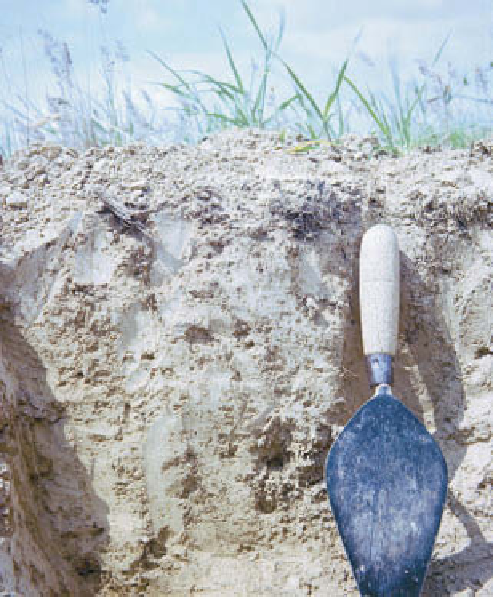Geoscience Reference
In-Depth Information
between capillary water and hygroscopic water is over
thirty-one bars, and the water in an oven-dried soil is held
at over 10,000 bars. Field capacity has been defined at
various suctions in the range 0·33-0·05 bar.
Table 19.2
also
indicates the pore diameter corresponding to the soil
suction, the physical appearance of the soil, and the
availability of the water to plants.
The amount of available water which can be stored in
any soil is influenced by soil texture, soil structure and the
organic matter content. These factors have a marked effect
on the size and distribution of the pore spaces. The
influence of texture on
storage capacity
or
available water-
holding capacity
is indicated in
Table 19.3
.
In many parts
of the world soil moisture is probably the major factor
limiting crop production, so this property of soils is of
enormous economic importance. The most accurate
method of determining the water content of a soil sample
is to measure the loss in weight when a moist soil is dried
in an oven at 105
soil depth)
Field
Wilting
Available
Soil texture
capacity
point
water
Sandy loam
5·6
2·8
2·8
Loam
8·4
4·3
4·1
Clay loam
9·9
5·3
4·6
Heavy clay
11·9
6·3
5·6
C overnight. The moisture content is
expressed as the loss in weight as a percentage of the oven-
dried soil.
The content of available water in soil correlates fairly
closely with total pore space, i.e.
porosity
. Fine textures like
clays and clay loams are able to hold considerably more
available water than coarse textures such as sands and
sandy loams (
Table 19.3
).
Excess gravitational water will
drain away from soil in macropores or transmission pores
larger than about 0·05 mm diameter. The ability of a soil
to allow water to pass through in this way is its
permeability. Again it is closely linked with soil texture and
soil structure. It has no relation to total porosity; clay soils
with high porosity usually have low permeability, and vice
versa with sandy soils. The important characteristic of
soils with a high permeability is their high content of large
pores (
Plate 19.2
),
wide cracks (
Plate 19.3
)
or faunal
burrows and channels. The soil physicist Darcy defined the
ability of a porous medium to transmit a fluid as the
cements, which allows maximum water infiltration in this
semi-arid region of Jordan.
Photo: Ken Atkinson
Table 19.2
Types of soil water
Suction held
Water
Pore diameter
Physical
(bars)
constant
(mm)
Type
state
Availability
10000
1000
H
Dry
Unavailable
31
Hygroscopic coefficient
0·001
15
Wilting point
0·002
C
Moist
Available
0·33
Field capacity
0·010
Wet
0·05
0·060
G
0·001
Saturated
Unavailable transient
Notes: H, hygroscopic; C, capillary; G, gravitational.
















































